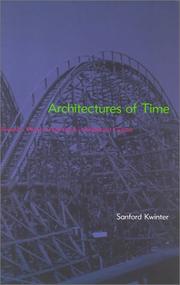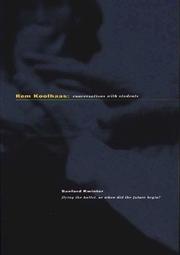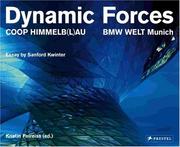| Listing 1 - 10 of 29 | << page >> |
Sort by
|

ISBN: 9788496540644 8496540642 Publisher: Barcelona Actar
Abstract | Keywords | Export | Availability | Bookmark
 Loading...
Loading...Choose an application
- Reference Manager
- EndNote
- RefWorks (Direct export to RefWorks)
Industrial design --- Design and technology. --- Design --- Design et technologie --- Environmental aspects. --- Aspect de l'environnement --- 13 --- 72.01 --- 711.4 --- Technologie --- Cultuurfilosofie --- Architectuurkritiek --- Architectuur (kritiek) --- Stedenbouw (kritiek) --- Applied arts. Arts and crafts --- Architecture --- architectuurfilosofie

ISBN: 0262611813 0262112604 9780262611817 Year: 2001 Publisher: Cambridge (Mass.): MIT press
Abstract | Keywords | Export | Availability | Bookmark
 Loading...
Loading...Choose an application
- Reference Manager
- EndNote
- RefWorks (Direct export to RefWorks)
An exploration of twentieth-century conceptions of time and their relation to artistic form. In Architectures of Time, Sanford Kwinter offers a critical guide to the modern history of time and to the interplay between the physical sciences and the arts. Tracing the transformation of twentieth-century epistemology to the rise of thermodynamics and statistical mechanics, Kwinter explains how the demise of the concept of absolute time, and of the classical notion of space as a fixed background against which things occur, led to field theory and a physics of the "event." He suggests that the closed, controlled, and mechanical world of physics gave way to the approximate, active, and qualitative world of biology as a model of both scientific and metaphysical explanation.Kwinter examines theory of time and space in Einstein's theories of relativity and shows how these ideas were reflected in the writings of the sculptor Umberto Boccioni, the town planning schema of the Futurist architect Antonio Sant'Elia, the philosophy of Henri Bergson, and the writings of Franz Kafka. He argues that the writings of Boccioni and the visionary architecture of Sant'Elia represent the earliest and most profound deployments of the concepts of field and event. In discussing Kafka's work, he moves away from the thermodynamic model in favor of the closely related one of Bergsonian duree, or virtuality. He argues that Kafka's work manifests a coherent cosmology that can be understood only in relation to the constant temporal flux that underlies it.
72.01 --- Architectuurtheorie over de Moderne Beweging --- Architectuur en wiskunde architectuur en wetenschap --- Architectuur 1ste h. 20ste eeuw --- Modernisme --- Architectuur theorie, filosofie, esthetica --- Modern Movement (Architecture) --- Modernism (Architecture) --- Modernist architecture --- Modern movement (Architecture). --- Modern movement (Architecture) --- Architecture, Modern --- Mouvement moderne (Architecture) --- Architecture --- International style (Architecture) --- Architectuur ; 1ste h. 20ste eeuw --- Architectuur en wiskunde ; architectuur en wetenschap --- Architectuurtheorie ; over de Moderne Beweging --- Architectuur ; theorie, filosofie, esthetica
Book
Year: 2010 Publisher: Barcelona : Actar,
Abstract | Keywords | Export | Availability | Bookmark
 Loading...
Loading...Choose an application
- Reference Manager
- EndNote
- RefWorks (Direct export to RefWorks)

ISBN: 1885232020 Year: 1996 Volume: no. 30. Publisher: Houston Rice University School of Architecture
Abstract | Keywords | Export | Availability | Bookmark
 Loading...
Loading...Choose an application
- Reference Manager
- EndNote
- RefWorks (Direct export to RefWorks)
Architecture --- Koolhaas, Rem --- Architecture, Modern --- Architects --- Architectural criticism --- Architectes --- Critique d'architecture --- Psychology. --- Psychologie --- Interviews --- Koolhaas, Rem °1944 (°Rotterdam, Nederland) --- Architectuur ; Rem Koolhaas ; gesprekken met studenten --- 72 KOOLHAAS, REM --- 72.036 --- 72.07 --- 72.038 --- 72.01 --- 72.01 Architectuurtheorie. Bouwprincipes. Esthetica van de bouwkunst. Filosofie van de bouwkunst --- Architectuurtheorie. Bouwprincipes. Esthetica van de bouwkunst. Filosofie van de bouwkunst --- 72.036 Moderne bouwkunst. Architectuur van de 20e eeuw --- Moderne bouwkunst. Architectuur van de 20e eeuw --- 72 KOOLHAAS, REM Architectuur. Bouwkunst--KOOLHAAS, REM --- Architectuur. Bouwkunst--KOOLHAAS, REM --- Architecten. Stedenbouwkundigen A - Z --- Architectuurgeschiedenis ; 1950 - 2000 --- Koolhaas, Rem, --- Professional employees --- Psychology --- History --- Interviews. --- 72.01 Theory and philosophy of architecture. Principles of design, proportion, optical effect --- Theory and philosophy of architecture. Principles of design, proportion, optical effect
Book
ISSN: 13207253 ISBN: 1875498214 9781875498215 Year: 1995 Volume: 9 Publisher: Mulgrave Images Publishing
Abstract | Keywords | Export | Availability | Bookmark
 Loading...
Loading...Choose an application
- Reference Manager
- EndNote
- RefWorks (Direct export to RefWorks)
It is difficult to say which is the more impressive career accomplishment: to have generated an endlessly renewed trail of agitative hypotheses over a 30-year period, or to have eschewed nearly all the comforts of consolidation - and the inevitable complacencies - afforded by conventional, repeatable "successes" such as the production of "great" buildings or the development of a signature style. In both these respects, Peter Eisenman differs not only from other architechts of his own generation, but from nearly all other architects working today." "When Eisenman's work began in the early sixties, it was, and remains to this day, a primarily tactical enterprise: its force from the outset was drafted from that of the enemy - classicism - but was also turned aggressively against it... Eisenman's task has been to develop a practice that, to borrow an expression from Foucault and Nietzsche, would come from outside... There is not now, nor has there ever been, a fixable Eisenmanian alternative architecture; tactical space after all is made up of a series of seized "occasions," so that the momentary triumphs that punctuate its unfolding campaign are never - indeed cannot be - stored. Eisenman's practice is assembled and articulated in movement and in the spirit of movement; it operates through invasion, disruption, and the release of temporarily trapped forces into free motion and recombination.
Architecture, American. --- Architecture --- Architects --- Architecture américaine --- Architectes --- History --- Histoire --- Eisenman, Peter, --- Eisenman Architects. --- Eisenman, Peter --- Peter Eisenman --- architectuur --- architecten --- 72.071 --- buitenlandse architecten --- Architecture, Modern --- Catalogs. --- Architecture américaine --- Catalogs --- Eisenman, Peter D., --- Aizenman, Pītā, --- Eisenman Architects --- Eisenman/Robertson Architects --- Eisenman/Trott Architects --- Architecture - 20e siècle - Catalogue --- Eisenman, Peter, - 1932- - Catalogue --- Eisenman, Peter, - 1932 --- -Architecture, Modern
Book
Abstract | Keywords | Export | Availability | Bookmark
 Loading...
Loading...Choose an application
- Reference Manager
- EndNote
- RefWorks (Direct export to RefWorks)

ISBN: 9783791338767 Year: 2007 Publisher: Munich Prestel
Abstract | Keywords | Export | Availability | Bookmark
 Loading...
Loading...Choose an application
- Reference Manager
- EndNote
- RefWorks (Direct export to RefWorks)
Architects --- Architectural firms --- Architecture --- Exhibition buildings --- Office buildings --- History --- Design and construction --- Design and construction --- BMW Group. --- Coop Himmelblau. --- Munich (Germany) --- Buildings, structures, etc.
Book
ISBN: 9788492861200 Year: 2010 Publisher: Barcelona Actar.
Abstract | Keywords | Export | Availability | Bookmark
 Loading...
Loading...Choose an application
- Reference Manager
- EndNote
- RefWorks (Direct export to RefWorks)
In this small, but sharply-pointed book, renowned theorist Sanford Kwinter addresses the sometimes subtle, sometimes brutal transformations that characterized the modernization processes set into motion at the turn of the millennium. From the strange appearance of the 'Trojan Horse' that was the Centre Pompidou which served as the harbinger and template of the new idea of "Europe", through the dot.com bubble of the late 1990s, to the destruction of the World Trade Center Towers in New York, a new world came into being that design thinking has yet to fully take into account. The City is here seen not only as the last frontier of human history currently under threat of total eclipse, it is the indomitable form of collective experience upon which one can count as assuredly as one can on death and taxes. Requiem, to quote from Thomas Daniell's introduction, is first and foremost redemptive: "Kwinter's most negative assessments of the city are driven by a deep commitment to its sublime potentials--a desire to sacralize the most profane and fecund of human creations".

ISBN: 1580931316 Year: 2004 Publisher: New York Monacelli
Abstract | Keywords | Export | Availability | Bookmark
 Loading...
Loading...Choose an application
- Reference Manager
- EndNote
- RefWorks (Direct export to RefWorks)
Verenigde Staten van Amerika --- Architecture --- Mathematics. --- History --- Bell, Michael --- Bell, Michael.
Book
ISBN: 9783037782521 3037782528 Year: 2012 Publisher: Zürich Müller
Abstract | Keywords | Export | Availability | Bookmark
 Loading...
Loading...Choose an application
- Reference Manager
- EndNote
- RefWorks (Direct export to RefWorks)
"Couleur, temps et lumière" fait référence aux travaux de l'architecte Steven Holl à New York. Pendant près de trois décennies, Steven Holl a développé son langage architectural et ses réflexions sur l'architecture avec une cohérence frappante. Le succès de son travail peut être attribué à sa mise en forme sculpturale, son intérêt pour la poétique de l'espace, la couleur, la lumière et la matière, et sa fascination pour les phénomènes scientifiques. Ces trois essais analysent les aspects archétypaux de la perception visuelle, qui jouent un rôle essentiel dans le travail de Holl. Color Light Time sets out to examine the current work of New York-based architect Steven Holl, one of the most outstanding representatives of contemporary American architecture. For nearly three decades now, Steven Holl has developed his architectural idiom and his reflections on architecture with striking consistency. The success of his work can be attributed to its sculptural shaping, his interest in the poetics of space, color, light, and material, and his fascination with scientific phenomena. Numerous illustrations and three essays closely examine archetypical aspects of visual perception, which play an essential role in Holl's work.
72 --- 72.01 --- 72.01 Architectuurtheorie. Bouwprincipes. Esthetica van de bouwkunst. Filosofie van de bouwkunst --- Architectuurtheorie. Bouwprincipes. Esthetica van de bouwkunst. Filosofie van de bouwkunst --- 72 Architectuur. Bouwkunst --- 72 Architecture --- Architecture --- Architectuur. Bouwkunst --- Architecture contemporaine --- Couleur --- Lumière --- Ecrit d'architecte --- Image de l'architecture --- Perception de l'architecture --- Perception de l'espace --- Holl, Steven --- Holl, Steven, --- 72.01 Theory and philosophy of architecture. Principles of design, proportion, optical effect --- Theory and philosophy of architecture. Principles of design, proportion, optical effect --- Holl, Steven, 1947 --- -72 --- -Architecture contemporaine --- Holl, Steven, 1947-
| Listing 1 - 10 of 29 | << page >> |
Sort by
|

 Search
Search Feedback
Feedback About UniCat
About UniCat  Help
Help News
News